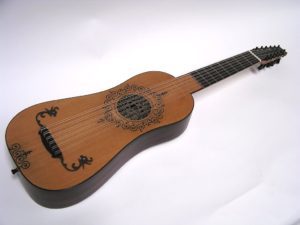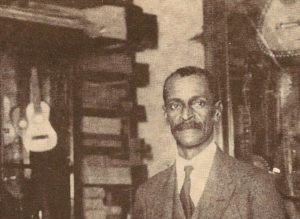Brazilian Guitar – Violão Brasileiro
If there is an instrument that is considered very Brazilian, we can say it is the violão or the acoustic guitar. At least in the hearts of Brazilian the guitar, o violão, is Brazilian. The guitar has its origins in Europe, Spain, Portugal and Italy. The vihuela, as it was known in Spanish, was called the viola de mà in Catalan, viola da mano in Italian and viola de mão in Portuguese. The vihuela was a guitar-shaped instrument with six double-strings (paired courses) made of gut. Plucked vihuelas, being essentially flat-backed lutes, evolved in the mid-15th century, in the Kingdom of Aragón, located in north-eastern Iberia (Spain). In Spain, Portugal, and Italy the vihuela was in common use by the late 15th through to the late 16th centuries. In the second half of the 15th century some vihuela players began using a bow, leading to the development of the violin. 
The first person to publish a collection of music for the vihuela was the Spanish composer Luis Milán, with his volume titled Libro de música de vihuela de mano intitulado El maestro of 1536 dedicated to King John III of Portugal. The guitar was brought to Brazil by the Portuguese early on during the colonial times (1530 – 1700).
In Spanish, the guitar is called guitarra. It also happens that the Portuguese have an instrument very similar to the Spanish guitar, which would be equivalent to the Brazilian Viola Caipira: It is the Portuguese Viola. It has the same forms and characteristics of the guitar, being only slightly smaller. When the Portuguese encountered the “guitarra” (Spanish), they saw that it was equal to their viola, being only slightly larger. Then they put the name of the instrument in the augmentative, that is, the “Viola” came to be called violão.
The first known musical string instrument brought to Brazil was the viola of ten strings – or five double strings – brought by the Portuguese Jesuits whose goal was to convert the Indians to Christianity and used the instrument during this process.

The characteristic of urban use of the “violão”, in its current form was established at the end of the nineteenth century. Because of this, the guitar became the favorite instrument for vocal accompaniment, as in the case of the “modinhas”, romantic tunes brought to Brazil by the Portuguese, and, also, in instrumental music, accompanying the flute and the cavaquinho, forming the basis of choro ensembles developing in the late 1800’s in Rio de Janeiro.
The guitar, being an instrument widely used in Brazilian popular music, and by people in general, came to have a bad reputation, being considered by many as an instrument of bohemians, used in serenades, chorões, and becoming a symbol of vagrancy. This stigma lasted for many years. Due to this discrimination, the first musicians who tried to demystify it and promote it as a serious instrument were considered true heroes. One of the forerunners of the modern guitar in Brazil was the founder of the magazine “O Violão”, published in 1928, Joaquim Santos (1873-1935) or Quincas Laranjeira. He was considered the “father of the modern guitar” and in the last years of his life was dedicated to teaching guitar by the method of Tárrega.
Maestro Heitor Villa-Lobos, one of Brazil’s foremost classical composers, also wrote his famed “Etudes for Guitar “(1929), dedicated to Andres Segovia.

The viola of ten strings – or five double strings – brought to Brazil by the Portuguese Jesuits in the sixteenth century, was the first musical instrument sold in the country, and had a very high price at the time: Two thousand reis! This instrument belonged to a “bandeirante” (pioneer) called Sebastião Paes de Barros.
We can say the violão is found in many Brazilian music styles. In choro, samba, boss nova, as well as instrumental Brazilian music.
It is hard to imagine samba and bossa nova without a guitar/violão.
The pioneers of Bossa Nova all played the guitar: Laurindo Almeida, Luiz Bonfá and João Gilberto, Antonio Carlos Jobim, Roberto Menescal, Carlos Lyra. Nara Leão.Who can forget the guitar style of Baden Powell, Paulinho Nogueira, Dilermando Reis, João Pernambuco. And later, Luiz Bonfá and Laurindo Almeida took the Brazilian guitar styles around the world.
The seven-string guitar is also very popular in Brazil used in many styles of music. Some seven-string guitarists who contributed to Brazilian music with their compositions and guitar technique: Dino 7 Cordas, Rafael Rabello and Yamandú Costa.
As we look at the evolution of the guitar and techniques we also remember Egberto Gismonti with performance and compositions for a nylon and steel ten-string guitar.

Because of its history and our history, the guitar/violão seems to be indeed Brazilian. The guitar is used in the music of the gauchos in Southern Brazil and with the seringueiros, rubber tappers in the villages of the Amazon region. It’s in the sounds of the street vendors in the Northeast, the caipira music, or country music in the States of São Paulo and Minas Gerais, as well as in concert halls throughout Brazil. It was part of the protest songs and MPB of the 60’s and 70’s. It was central to the Bossa Nova being developed in the apartments of Copacabana by Roberto Menescal, and Carlos Lyra, and it’s hard to imagine Milton Nascimento, Chico Buarque, Dori Caymmi, Joyce, Rosinha de Valença, Paulinho da Viola, Cartola and João Bosco without a guitar.
The guitar seems to be part of the collective spirit and heart of Brazilians – it is part of the sound track of our history.
Join us for a very special Brazilian Music Get Together at the Vinicius de Moraes Gallery at the Brazilian Consulate in Los Angeles on August 16 at 6:30 PM for a Night of Guitar featuring: Fabiano do Nascimento, JP Mourão, Marcel Camargo, and Capital.
Brazilian Consulate General
8484 Wilshire Blvd., Suite 300
Beverly Hills, CA., 90211
RSVP















